一、IoU简介
IoU又名交并比,是一种计算不同图像相互重叠比例的算法,时常被用于深度学习领域的目标检测或语义分割任务中。
1、在目标检测中的应用
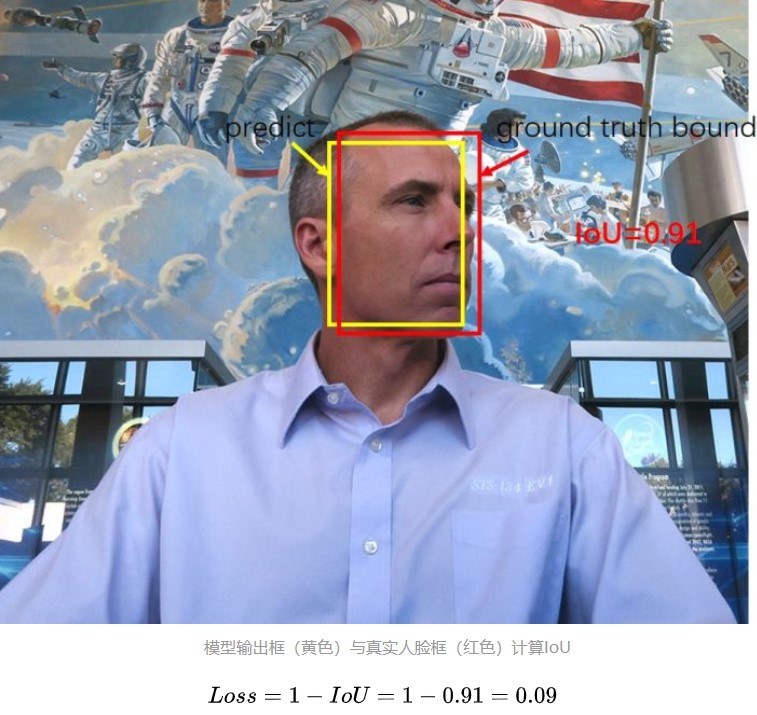
2、在语义分割中的应用
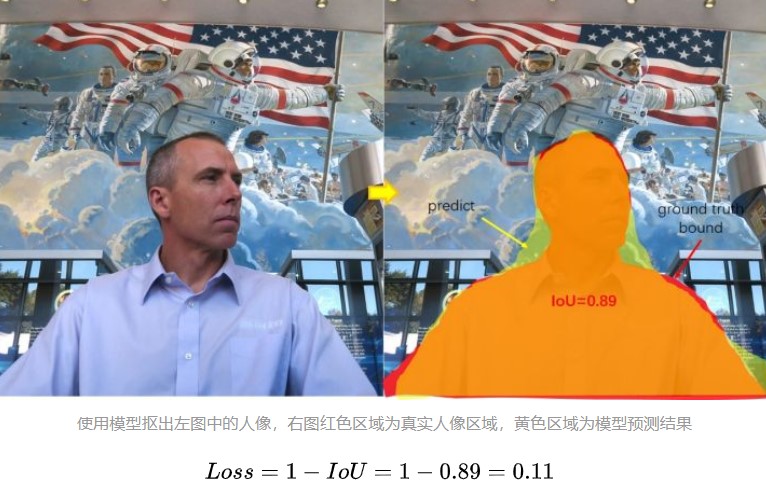
二、IoU原理
1、定义
IoU的定义如下:

直观来讲,我们可以把IoU的值定为为两个图形面积的交集和并集的比值。
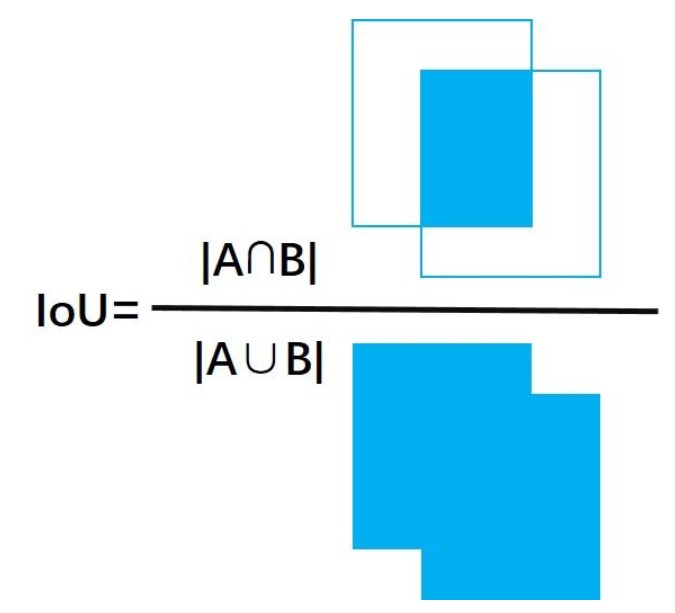
2、计算
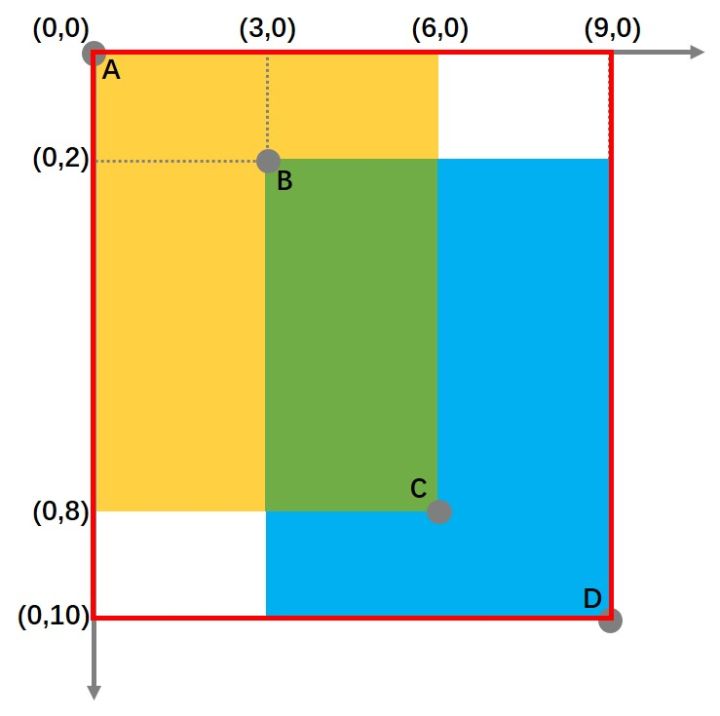
如上图所示,黄色矩形与蓝色矩形相交,他们的顶点A、B、C、D分别是(0,0)、(3,2)、(6,8)、(9,10)
此时IoU的计算公式应为:

带入A、B、C、D四点的实际坐标后,可以得到:

三、IoU的代码实现
1
2
3
4
5
6
7
8
9
10
11
12
13
14
15
16
17
18
19
20
21
| def IoU(boxA, boxB):
in_h = min(box1[2], box2[2]) - max(box1[0], box2[0])
in_w = min(box1[3], box2[3]) - max(box1[1], box2[1])
interArea = 0 if in_h < 0 or in_w < 0 else in_h * in_w
unionArea = (box1[2] - box1[0]) * (box1[3] - box1[1]) + \
(box2[2] - box2[0]) * (box2[3] - box2[1]) - interArea
IoU = interArea/unionArea
return IoU
box1 = [0, 0, 8, 6]
box2 = [2, 3, 10, 9]
print(IoU(box1, box2))
|
四、IoU的改进
1、GIoU
GIoU(Generalized Intersection over Union)相较于IoU多了一个”Generalized”,这也意味着它能在更广义的层面上计算IoU,并解决”两个图像没有相交时,无法比较两个图像的距离远近”的问题。
GIoU的计算公式为:

其中C代表两个图像的最小包庇面积,也可以理解为这两个图像的最小外接矩形的面积。

计算GIoU:

1
2
3
4
5
6
7
8
9
10
11
12
13
14
15
16
17
18
19
20
21
22
23
24
25
26
27
28
29
| def GIoU(boxA, boxB):
cArea = (max(boxA[0], boxA[2], boxB[0], boxB[2]) - min(boxA[0], boxA[2], boxB[0], boxB[2])) * \
(max(boxA[1], boxA[3], boxB[1], boxB[3]) - min(boxA[1], boxA[3], boxB[1], boxB[3]))
in_h = min(box1[2], box2[2]) - max(box1[0], box2[0])
in_w = min(box1[3], box2[3]) - max(box1[1], box2[1])
interArea = 0 if in_h < 0 or in_w < 0 else in_h * in_w
unionArea = (box1[2] - box1[0]) * (box1[3] - box1[1]) + \
(box2[2] - box2[0]) * (box2[3] - box2[1]) - interArea
IoU = interArea/unionArea
endArea = (cArea - unionArea)/cArea
GIoU = IoU - endArea
return GIoU
box1 = [0, 0, 8, 6]
box2 = [2, 3, 10, 9]
print(GIoU(box1, box2))
|
2、DIoU
GIoU虽然解决了IoU的一些问题,但是它并不能直接反映预测框与目标框之间的距离,DIoU(Distance-IoU)解决了这一问题,它将两个框之间的重叠度、距离、尺度都考虑了进来。
DIoU的计算公式如下:

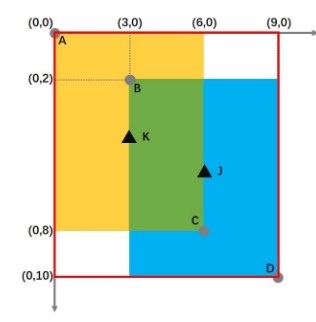
通过计算可得,黄框中心点K、蓝框中心点J的坐标分别为(3,4)、(6,6)
计算DIoU:

1
2
3
4
5
6
7
8
9
10
11
12
13
14
15
16
17
18
19
20
21
22
23
24
25
26
27
28
29
30
31
32
33
34
35
36
37
38
39
40
41
42
43
| import numpy as np
def IoU(boxA, boxB):
in_h = min(box1[2], box2[2]) - max(box1[0], box2[0])
in_w = min(box1[3], box2[3]) - max(box1[1], box2[1])
interArea = 0 if in_h < 0 or in_w < 0 else in_h * in_w
unionArea = (box1[2] - box1[0]) * (box1[3] - box1[1]) + \
(box2[2] - box2[0]) * (box2[3] - box2[1]) - interArea
IoU = interArea/unionArea
return IoU
def DIoU(boxA, boxB):
c = np.sqrt((max(boxA[0], boxA[2], boxB[0], boxB[2]) - min(boxA[0], boxA[2], boxB[0], boxB[2]))**2 + \
(max(boxA[1], boxA[3], boxB[1], boxB[3]) - min(boxA[1], boxA[3], boxB[1], boxB[3]))**2)
point_1 = ((boxA[0] + boxA[2])/2, (boxA[1] + boxA[3])/2)
point_2 = ((boxB[0] + boxB[2])/2, (boxB[1] + boxB[3])/2)
d = np.sqrt((point_2[0] - point_1[0])**2 + (point_2[1] - point_1[1])**2)
iou = IoU(boxA, boxB)
lens = d**2 / c**2
diou = iou - lens
return diou
box1 = [0, 0, 8, 6]
box2 = [2, 3, 10, 9]
print(DIoU(box1, box2))
|
3、CIoU
CIoU的全称为Complete IoU,它在DIoU的基础上,还能同时考虑两个矩形的长宽比,也就是形状的相似性。
CIoU的计算公式如下:

其中α是权重函数,而v用来度量长宽比的相似性:
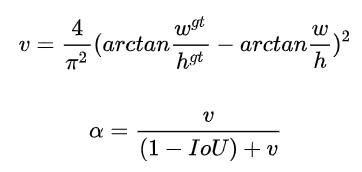
可以看出,CIoU就是在DIoU的基础上,增加了图像相似性的影响因子,因此可以更好的反映两个框之间的差异性。

通过计算可得,黄框中心点K、蓝框中心点J的坐标分别为(3,4)、(6,6)
计算CIoU:
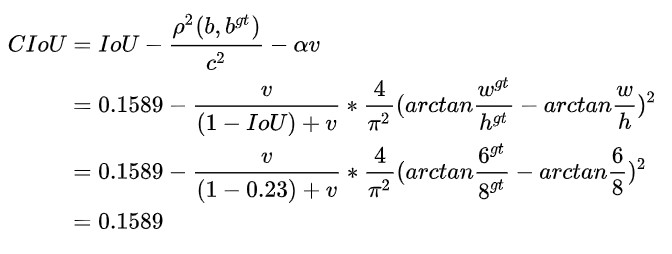
两个形状差别越大,CIoU相较于DIoU则越小。
1
2
3
4
5
6
7
8
9
10
11
12
13
14
15
16
17
18
19
20
21
22
23
24
25
26
27
28
29
30
31
32
33
34
35
36
37
38
39
40
41
42
43
44
45
46
47
48
49
50
51
52
| import numpy as np
import math
def IoU(boxA, boxB):
in_h = min(box1[2], box2[2]) - max(box1[0], box2[0])
in_w = min(box1[3], box2[3]) - max(box1[1], box2[1])
interArea = 0 if in_h < 0 or in_w < 0 else in_h * in_w
unionArea = (box1[2] - box1[0]) * (box1[3] - box1[1]) + \
(box2[2] - box2[0]) * (box2[3] - box2[1]) - interArea
IoU = interArea/unionArea
return IoU
def DIoU(boxA, boxB):
c = np.sqrt((max(boxA[0], boxA[2], boxB[0], boxB[2]) - min(boxA[0], boxA[2], boxB[0], boxB[2]))**2 + \
(max(boxA[1], boxA[3], boxB[1], boxB[3]) - min(boxA[1], boxA[3], boxB[1], boxB[3]))**2)
point_1 = ((boxA[0] + boxA[2])/2, (boxA[1] + boxA[3])/2)
point_2 = ((boxB[0] + boxB[2])/2, (boxB[1] + boxB[3])/2)
d = np.sqrt((point_2[0] - point_1[0])**2 + (point_2[1] - point_1[1])**2)
iou = IoU(boxA, boxB)
lens = d**2 / c**2
diou = iou - lens
return diou
def CIoU(boxA, boxB):
iou = IoU(box1, box2)
diou = DIoU(box1, box2)
v = 4/math.pi**2 * (math.atan((boxA[2] - boxA[0])/(boxA[3] - boxA[1])) - math.atan((boxB[2] - boxB[0])/(boxB[3] - boxB[1])))**2
alpha = v / (1-iou) + v
ciou = diou - alpha * v
return ciou
box1 = [0, 0, 8, 6]
box2 = [2, 3, 10, 9]
print(CIoU(box1, box2))
|
















